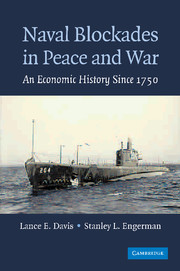Book contents
- Frontmatter
- Contents
- Preface
- 1 Introduction: “Thou Shalt Not Pass”
- 2 Britain, France, and Napoleon's Continental System, 1793–1815
- 3 The United States versus Great Britain, 1776–1815
- 4 The North Blockades the Confederacy, 1861–1865
- 5 International Law and Naval Blockades during World War I: Britain, Germany, and the United States: Traditional Strategies versus the Submarine
- 6 Legal and Economic Aspects of Naval Blockades: The United States, Great Britain, and Germany in World War II
- 7 The American Submarine and Aerial Mine Blockade of the Japanese Home Islands, 1941–1945
- 8 Blockades without War: From Pacific Blockades to Sanctions
- 9 Blockades, War, and International Law: What It All Means
- Conclusion
- Index
6 - Legal and Economic Aspects of Naval Blockades: The United States, Great Britain, and Germany in World War II
Published online by Cambridge University Press: 18 August 2009
- Frontmatter
- Contents
- Preface
- 1 Introduction: “Thou Shalt Not Pass”
- 2 Britain, France, and Napoleon's Continental System, 1793–1815
- 3 The United States versus Great Britain, 1776–1815
- 4 The North Blockades the Confederacy, 1861–1865
- 5 International Law and Naval Blockades during World War I: Britain, Germany, and the United States: Traditional Strategies versus the Submarine
- 6 Legal and Economic Aspects of Naval Blockades: The United States, Great Britain, and Germany in World War II
- 7 The American Submarine and Aerial Mine Blockade of the Japanese Home Islands, 1941–1945
- 8 Blockades without War: From Pacific Blockades to Sanctions
- 9 Blockades, War, and International Law: What It All Means
- Conclusion
- Index
Summary
INTRODUCTION
By World War I, improvements in technology, particularly the innovation of long-range coastal defense guns, mines, and submarines, had all but ruled out “close blockades” of the type that characterized warfare from the English-French continental wars of the eighteenth century through at least the American Civil War. Earlier, most blockades were “close blockades,” that “must be confined to ports and coasts belonging to or occupied by the enemy.” By 1914, however, “close” blockades had been replaced by “distant” ones. The blockading vessels were now almost always positioned further out to sea, with a corresponding potential for more contact with nonbelligerent shipping; however, as long as the blockade can adequately restrict movements into and out of enemy ports, this form of interdiction is considered legally valid.
Another important change is that although in the twentieth century most blockades have been enforced by government-owned-and-operated vessels, in the past the blockading vessels have included private ships operating under letters of marque as government approved privateers. Historically, the distinction between private and government blockades raised a number of issues including legal questions of controls over appropriate behavior and domestic questions involving the relative size of peacetime and wartime navies.
LESSONS FROM THE PAST: WORLD WAR I
Given its precursors and the size of the conflagration, it is not surprising that policies adopted during World War I almost entirely rewrote the rules of naval blockades; and the history of the war itself appeared to confirm that, in the future, the convoy was to become the ultimate weapon against a “distant” blockade.
- Type
- Chapter
- Information
- Naval Blockades in Peace and WarAn Economic History since 1750, pp. 239 - 320Publisher: Cambridge University PressPrint publication year: 2006



